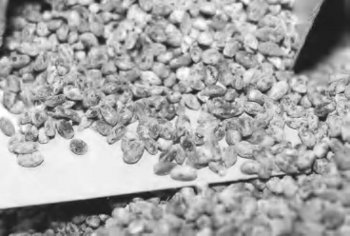Spawn Production
The process of making spawn remains much the same as Penn State professor emeritus Dr. Sinden first developed in the 1930s. Grain is mixed with a little calcium carbonate, then cooked, sterilized, and cooled. Small pieces of pure-culture mycelium are placed in small batches on the grain. Once the small batch is fully colonized, it is used to inoculate several larger batches of grain (Figure 11). This multiplying of the inoculated grain continues until the commercial-size containers — usually plastic bags with breathable filter patches — are inoculated. During the colonization of each batch, the containers are shaken every few days to distribute actively growing mycelia around the bag or bottle. During the process, temperatures are maintained at 74–76ºF (23–24ºC). Uniformity of the air circulating around the bags is important to ensure that all containers are kept within the desired temperature range. Mycelium is sensitive and its fruiting mechanism can be easily damaged at high temperatures.

Figure 11. Spawn grains used to seed the compost with mushroom mycelia.
Spawn is cooked, sterilized, grain cooled, and inoculated with mushroom mycelia.
5102 view.